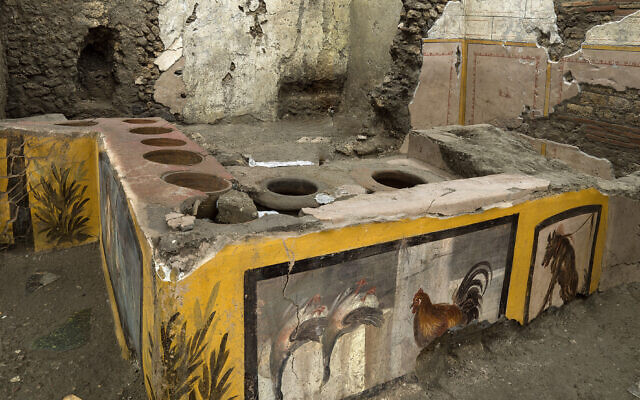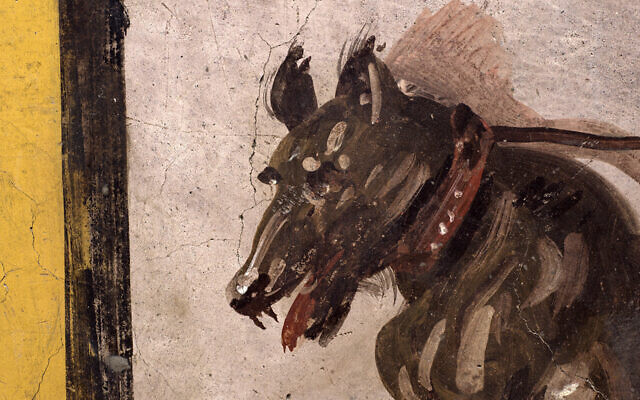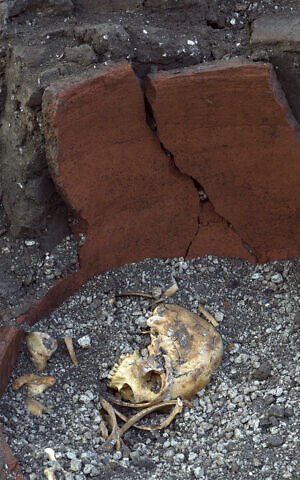Duck, pig, fish, snail… and wine with crushed fava beans were on menu, archaeologists say, as first hot-food-drink eatery — known as a thermopolium — is excavated

ROME — Researchers said on Saturday they had fully unearthed a frescoed thermopolium, or fast food counter, in an exceptional state of preservation in Pompeii.
The ornate snack bar counter, decorated with polychrome patterns and frozen by volcanic ash, was partially exhumed last year but archaeologists extended work on the site to reveal it in its full glory.
Pompeii was buried in a sea of boiling lava when the volcano on nearby Mount Vesuvius erupted in 79 AD, killing between 2,000 and 15,000 people.
However, archaeologists continue to make discoveries there.
The Thermopolium of Regio V at what was a busy intersection of Silver Wedding Street and Alley of Balconies was the Roman era equivalent of a fast-food snack stall.
Previously unearthed was a fresco bearing an image of a Nereid nymph riding a seahorse and gladiators in combat.
In the latest stage of their work, archaeologists uncovered a number of still life scenes, including depictions of animals believed to have been on the menu, notably mallard ducks and also a rooster, for serving up with wine or hot beverages.
Scientists were also able to glean precious new information on gastronomic habits in the town dating from the eruption, which engulfed Pompeii and the neighboring town of Herculaneum as they tried to flee only to be engulfed by pyroclastic lava currents or hit by falling buildings.
The team found duck bone fragments as well as the remains of pigs, goats, fish and snails in earthenware pots. Some of the ingredients had been cooked together rather as a Roman-era paella.
Crushed fava beans, used to modify the taste of wine, were found at the bottom of one jar.
Pompeii Archaeological Park’s longtime chief, Massimo Osanna said this is the first time such a hot-food-drink eatery was completely unearthed.
After a segment of the fast-food counter was partially dug up in 2019 during work to shore up Pompeii’s oft-crumbling ruins, archaeologists kept digging, revealing a multi-sided-counter, with typical wide holes inserted into its top. The countertop held deep vessels for hot foods, not unlike soup containers nestled into modern-day salad bars.
Plant and animal specialists are still analyzing remains from the site. Images of two upside-down mallards and a rooster, whose plumage was painted with the typical vivid color known as Pompeiian red, also brightened the eatery and likely served to advertise the menu.
Another fresco depicted a dog on a leash, perhaps not unlike modern reminders to leash pets. Vulgar graffiti were inscribed on the painting’s frame.

Valeria Amoretti, a Pompeii staff anthropologist, said “initial analyses confirm how the painted images represent, at least in part, the foods and beverages effectively sold inside.” Her statement noted that duck bone fragment was found in one of the containers, along with remains from goats, pigs, fish and snails. At the bottom of a wine container were traces of ground fava beans, which in ancient times were added to wine for flavor and to lighten its color, Amoretti said.
“We know what they were eating that day,” said Osanna, referring to the day of Pompeii’s destruction in 79 A.D. The food remains indicated “what’s popular with the common folk,” Osanna told Rai state TV, noting that street-food places weren’t frequented by the Roman elite.
One surprise find was the complete skeleton of a dog. The discovery intrigued the excavators, since it wasn’t a “large, muscular dog like that painted on the counter but of an extremely small example” of an adult dog, whose height at shoulder level was 20-to-25 centimeters (8-to-10 inches), Amoretti said. It’s rather rare, Amoretti said, to find remains from ancient times of such small dogs, discoveries that “attest to selective breeding in the Roman epoch to obtain this result.”

Also unearthed were a bronze ladle, nine amphorae, which were popular food containers in Roman times, a couple of flasks and a ceramic oil container.
Successful restaurateurs know that a good location can be crucial, and the operator of this ancient fast-food seemed to have found a good spot. Osanna noted that right outside the eatery was a small square with a fountain, with another thermopolium in the vicinity.
Pompeii was destroyed by the volcanic eruption of Mount Vesuvius, which is near present-day Naples. Much of the ancient city still lies unexcavated. The site is one of Italy’s most popular tourist attractions.
Human remains were also discovered in the excavation of the eatery.
Those bones were apparently disturbed in the 17th century during clandestine excavations by thieves looking for valuables, Pompeii authorities said. Some of the bones belonged to a man, who, when the Vesuvius volcano erupted, appeared to have been lying on a bed or a cot, since nails and pieces of wood were found under his body, authorities said. Other human remains were found inside one of the counter’s vessels, possibly placed there by those excavators centuries ago.
As reported by The Times of Israel
